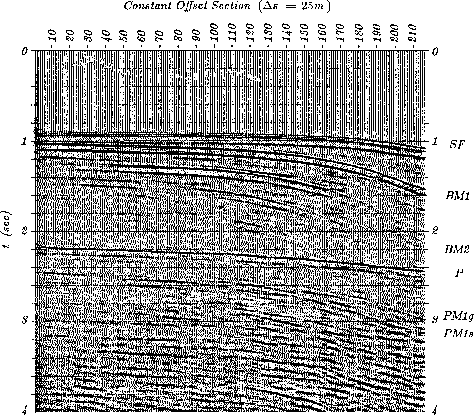We are preparing a general strategy, impedance replacement, for dealing with surface multiple reflections. This strategy will require heavy artillery drawn from both regression theory and wave-extrapolation theory. So as not to lose sight of the goals, we will begin with an example drawn from an idealized geometry. That reality is not too far from this idealization was demonstrated by Larry Morley, whose doctoral dissertation [1982] illustrates a successful test of this method and describes the impedance-replacement strategy in more detail.
Imagine that the sea floor is flat. Near the shot the sea-floor reflection coefficient is taken as cs. Near the geophone it is taken to be cg. Near the geophone the reverberation pattern is
| |
(1) |
| |
(2) |
| |
(3) |
| |
(4) |
Figure 16, taken from Morley's dissertation, shows that split pegleg multiples are an observable phenomenon.
 |
His interpretation of the figure follows:
[The figure] is a constant-offset section (COS) from the same line for an offset halfway down the cable (a separation of 45 shot points with this geometry). The first-order pegleg multiple starting at 2.5 seconds on the left and running across to 3 seconds on the right is ``degenerate'' (unsplit) on the near-trace section but is split on the COS due to the sea-floor topography. The maximum split is some 200 mils around shot points 180-200. This occurs, as one might expect, where the sea floor has maximum dip; i.e., where the difference between sea-floor depths at the shot and geophone positions is greatest.
Most present processing ignores the Backus filter altogether and solves for an independent deconvolution filter for each seismic trace. This introduces a great number of free parameters. By comparison, a split Backus approach should do a better job of preserving primaries.
In practice we would expect that any method based on the split Backus concept would need to include the effect of moveout. Luckily, velocity contrast would reduce the emerging angle for peglegs. Of course, residual moveout problems would be much more troublesome with water-bottom multiples. Presumably the process should be applied after normal moveout in that case. Let us take a look at the task of estimating a split Backus operator.